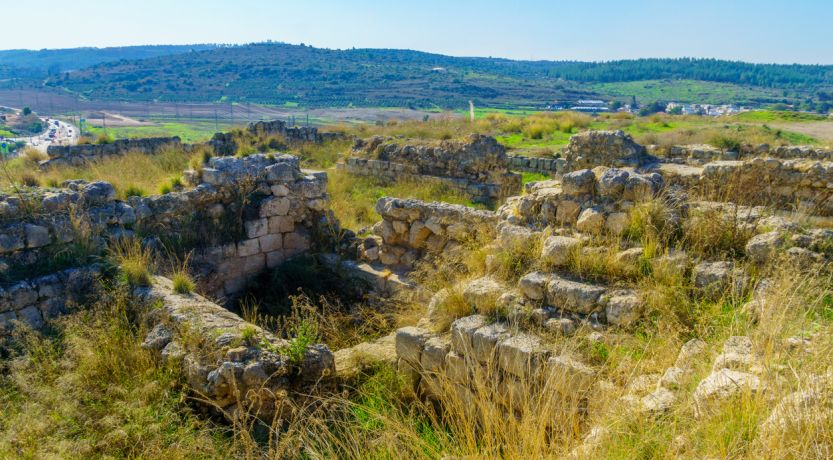Many have wondered about 1 Samuel 6:19. Did 50,070 men actually die for looking into the Ark of the Covenant? Could this be a copyist error?

View of ancient ruins in the archaeological site Tel Bet Shemesh, the town where many died for looking into the Ark of the Covenant. How many?
When God miraculously brought the Ark of the Covenant back from the Philistines, the men of Beth Shemesh foolishly decided to look inside the holy ark that represents God’s throne. They carelessly forgot God’s clear instructions about how to treat the ark. And the New King James Version says that “fifty thousand and seventy men” died.
Many have questioned whether towns like Beth Shemesh would have even had 50,000 people during that time period. How can this be explained? Was this an exact number? Was there an error in the original Bible, or could this be a copyist error passed down to today?
Answering Bible contradictions
We believe that the Bible is inspired by God, and that its original manuscripts were inerrant. However, none of the original manuscripts have survived the millennia. The manuscripts and translations we have today are the product of human copying and translation, so some errors have crept in.
Conservative scholars agree that the relatively few copyist errors can be adequately explained, though sometimes more than one explanation is possible. (To study more about finding the most accurate translations and about the veracity of the Bible, see “What Is the Most Accurate Bible Translation?” and our booklet Is the Bible True?)
Different translations of 1 Samuel 6:19
Here is the New King James translation of 1 Samuel 6:19: “Then He struck the men of Beth Shemesh, because they had looked into the ark of the LORD. He struck fifty thousand and seventy men of the people, and the people lamented because the LORD had struck the people with a great slaughter.”
A variety of other translations give indications of the challenges of translating this passage.
- Young’s Literal Translation says, “He smiteth among the people seventy men—fifty chief men.”
- Holman Christian Standard Bible says, “He struck down 70 men out of 50,000 men.”
- The New King James Version margin offers the following alternative, “He struck seventy men of the people and fifty oxen of a man.”
But these translations are not widely accepted. The translations that have the most support give either 50,070 or 70. Which number is correct? Arguments have been proposed for both possibilities.
Did 50,070 die?
Those who believe the Masoretic reading of 50,070 is the most likely give reasons such as:
- It is described as a “great slaughter,” which doesn’t seem to describe 70 people. Notice other passages that use the same wording:
1 Samuel 4:10: “So the Philistines fought, and Israel was defeated, and every man fled to his tent. There was a very great slaughter, and there fell of Israel thirty thousand foot soldiers.”
2 Samuel 18:7: “The people of Israel were overthrown there before the servants of David, and a great slaughter of twenty thousand took place there that day.”
- Some suggest that the total included many Philistines who died earlier while holding on to the ark and not sending it back (1 Samuel 5:11-12; 6:5-6). The plagues on the Philistines were symbolized by the golden rats and tumors sent back to accompany the ark. After seven months, the various towns realized the power of the God of Israel (chapter 5). If the figure of 50,070 included only those from Beth Shemesh, it could have been described directly as, “Then He struck 50,070 of the men of Beth Shemesh” instead of “fifty thousand and seventy men of the people.”
Possible copyist error
On the other hand, other conservative scholars, such as Norman Geisler, Thomas Howe and Gleason Archer, believe 1 Samuel 6:19 contains a copyist error.
In When Critics Ask: A Popular Handbook of Bible Difficulties, Dr. Geisler and Dr. Howe wrote:
“First, this is most probably a scribal or transcription error. The numerical designation in Hebrew usually follows a certain pattern in which the larger number is written first, then the smaller number. The normal manner to write such a number would be ‘fifty thousand men and seventy men.’ However, in this instance, the numbers appear backward. The text actually reads ‘seventy men fifty thousand men.’ In addition, numerical designations are almost always connected by the conjunction ‘and’ so that the statement would read, ‘fifty thousand men and seventy men.’ Again this passage departs from the normal practice by omitting the ‘and.’ These factors have [led] many to suspect that the text was inadvertently corrupted in transmission.”
In The New International Encyclopedia of Bible Difficulties Dr. Archer wrote:
Whatever explanation turns out to be correct, we are sure that the inspiration and inerrancy of the Bible will be confirmed.
“There is very strong evidence to indicate that the original text of 1 Samuel 6:19 read a much lower number. That is to say, nowhere else is a figure like 50,070 written in this fashion according to biblical Hebrew . . . The fact that neither of these customary word orders was followed in the received Hebrew text of this passage gives rise to a very justified suspicion that the text was inadvertently garbled in the course of transmission . . .
“It is highly significant that even in the late first century A.D., Josephus (Antiquities 6.1.4) refers to the loss of life at Bethshemesh as only seventy, with no mention whatever of the ‘fifty thousand.’ There are also a few Hebrew manuscripts that entirely omit ‘fifty thousand man.’ Hence it is not necessary to defend this huge number as part of the text of the original, inerrant manuscript of 1 Samuel. Nor is it likely that more than seventy men would have become involved in the sacrilege of removing the golden propitiatory (KJV, ‘mercy seat’) from the ark of the covenant in order to see what was inside. It is hardly conceivable that fifty thousand persons would have filed by the opened ark in order to peer into its interior and satisfy themselves that it contained only the two tablets of the Decalogue (cf. 1 Kings 8:9). Therefore such an enormous loss of life is almost impossible to account for.”
Whatever explanation turns out to be correct, we are sure that the inspiration and inerrancy of the Bible will be confirmed.
The Ark of the Covenant in the Bible
Biblical episodes such as this one, and modern cultural references such as the Raiders of the Lost Ark movie, have sparked interest in the ark. In brief, here are a few facts about the Ark of the Covenant in the Bible.
- What was the Ark of the Covenant? God instructed Moses to build a box covered by a golden mercy seat with two cherubim on it (Exodus 25:10-22). This represented the throne of God.
- What was inside the Ark of the Covenant? The two tablets of the 10 Commandments were put into the ark (Exodus 25:16; 1 Kings 8:9). The “Book of the Law” was put beside the ark (Deuteronomy 31:26). The golden pot of manna and Aaron’s rod that budded were also associated with the ark (Hebrews 9:4), though they were not inside the ark when the temple was dedicated (2 Chronicles 5:10).
- Who can touch the Ark of the Covenant? After it was made, no one was to touch the ark. The priests were instructed to cover it with the veil and insert the poles when it was to be moved (Numbers 4:5-6). Then the Levites from the family of Kohath were to carry it by its poles, “but they shall not touch any holy thing, lest they die” (verse 15; see also 1 Chronicles 15:15).
- Who stole the Ark of the Covenant? In the Bible, the Philistines captured the ark and were punished for keeping it (1 Samuel 4:10 to 5:12; see our youth lesson “The Philistines and the Golden Tumors”). That is why the Philistines put the ark on a cart hitched to two milk cows removed from their calves. God miraculously caused the cows to head toward Israelite territory, which is how it ended up in Beth Shemesh (1 Samuel 6). Later, God’s temple was destroyed by the Babylonians and then the Romans, but the Bible does not tell us what happened to the ark.
You may be interested in other articles we have that include information about the Ark of the Covenant and the way God instructed that it be treated. The tribe of Levi was responsible for the Ark of the Covenant, as well as many other aspects of the religious life in ancient Israel. You can read more about this in our blog post “We Did Not Consult Him” and article “The Death of Uzza: Was God Unfair?”





